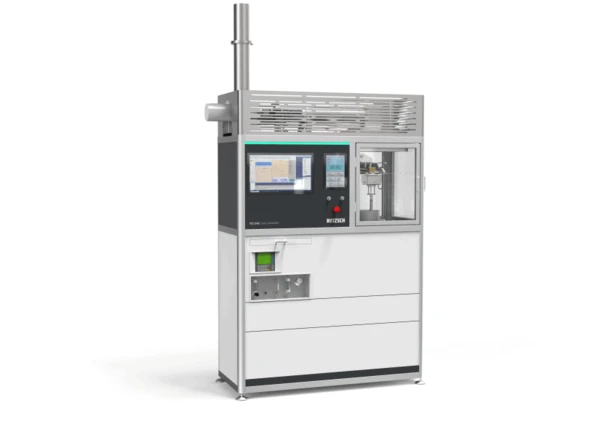
28.01.2021 by Gabriele Stock
Why the Cone Calorimeter in Accordance with ISO 5660-1 Is a Lifesaver
Fire testing regulations are crucial in keeping flammability and the spread of fire at a manageable level. The “Reaction to Fire Test” uses a Cone Calorimeter to assess the heat release rate and dynamic smoke production of a material sample. Learn how our new Cone Calorimeter allows for exact determination of the Heat Release Rate and gives an indication as to a material’s contribution to fire development and spread.
In June 2017, a fire broke out in the 24-storey Grenfell Tower in London. It burned for 60 hours and caused 72 deaths. The subsequent investigation confirmed that the building’s exterior did not comply with regulations. If the cladding used for this high rise had been compliant with the ISO 5660-1 or ASTM E1354 “Reaction to Fire Test”, the fire would not have spread so rapidly and this tragedy could have been avoided.
What Is a “Reaction to Fire Test” in Accordance with ISO 5660-1?
Fire testing regulations are crucial in keeping flammability and the spread of fire at a manageable level. The “Reaction to Fire Test” in accordance with International Standard ISO 5660-1 and ASTM E1354 uses a Cone Calorimeter to assess the heat release rate and dynamic smoke production of a material sample. Products that have to conform to ISO 5660-1 are typically textiles and polymers on public or private transport (cars, trains, planes and boats), building material such as cladding, and floor coverings. The Cone Calorimeter is also essential in determining the fire safety of newly developed materials.
How Does a Cone Calorimeter Work?
A Cone Calorimeter measures the combustibility and ignitability of a sample. The results give indications as to a material’s contribution to fire development and spread.
Instead of testing a whole product or set up, the Cone Calorimeter uses specific components, or a material’s representative of the end-use application, to perform this test.
A specimen of the size 100 by 100 mm is horizontally placed into the load cell. The material is then exposed to controlled levels of irradiance by the cone heater, ignited by sparks and consequently burned. The combustion gases produced pass through the heating cone and are collected by an exhaust duct system with a centrifugal fan and hood. In the exhaust duct, the gas flow is measured, as are O2, CO, and CO2 concentrations and smoke DensityThe mass density is defined as the ratio between mass and volume. density. A laser photometric beam determines the amount of smoke produced.

Why Is the Heat Release Rate (HRR) So Important and What Does the “Oxygen Consumption Principle” Have to Do with It?
The Heat Release Rate (HRR) is the rate of heat generated by fire. The HRR is the driving force of a fire. Therefore, the higher the HRR, the higher the flammability and the consequential fire hazard. The Cone Calorimeter uses the “Oxygen Consumption Principle” to measure the heat release rate. It is based on the fact that an amount x of heat is released per kilogram of oxygen consumed. The instrument measures the changes in oxygen and gas concentration in order to calculate the heat release rate of a material.
Why Is Compliance with ISO 5660-1 So Important?
The Cone Calorimeter is a fire-testing instrument which is widely used in the field of fire protection engineering. It allows for exact determination of the HRR and gives an indication as to a material’s contribution to fire development and spread by observing the way a fire develops in the very early stages. Being able to predict the real-scale fire behavior of a material helps to ensure the safe evacuation of buildings, planes, cars or boats in case of fire. This makes the Cone Calorimeter a true lifesaver.
If you need to know more about the new TCC 918 use the following link to contact us here!
Source Featured Image: https://en.wikipedia.org/wiki/Grenfell_Tower_fire#/media/File:Grenfell_Tower_fire_(wider_view).jpg